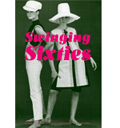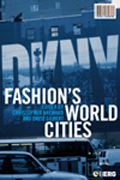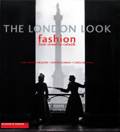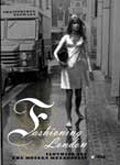
you are here: home > research projects > shopping routes
|
 |
|
|
Shopping Routes: Networks of Fashion Consumption in London's West End 1945-1979
Forty years on from Time Magazine’s celebrated identification of ‘Swinging London’, the 60s retain a powerful hold on the popular imagination, associated particularly with fashion and popular music. This multi-disciplinary research project places these mythologies within a more sophisticated study of the development of the West End as a centre of fashion consumption in the post-war period and its changing position in a hierarchy of world fashion cities.
This project ran from October 2003 to September 2006
click to visit this project's pages with London College of Fashion

Click to view this project's findings summary sheet
Project team
- Professor Christopher Breward (Director)
Victoria and Albert Museum, London.
- Dr David Gilbert (Co-Director)
Department of Geography, Royal Holloway, University of London.
- Pamela Church Gibson (Researcher)
London College of Fashion, The University of the Arts London.
- Dr Sonia Ashmore (Post-Doctoral Research Fellow)
London College of Fashion, The University of the Arts London.
- Dr Bronwen Edwards (Post-Doctoral Research Fellow)
Department of Geography, Royal Holloway, University of London.
- Dr Robert Lutton (Research Administrator)
London College of Fashion, The University of the Arts London.
Contact
Professor Christopher Breward
Deputy Head of Research
Victoria and Albert Museum
Cromwell Road
South Kensington SW7 2RL
c.breward@vam.ac.uk
Project activities included:
 Fashion's World Cities Conference
Fashion's World Cities Conference
Friday 29th-Saturday 30th April 2005
A conference at London College of Fashion and the Museum of London
London College of Fashion (University of the Arts, London), Royal Holloway University of London and the Victoria and Albert Museum, in association with the Museum of London, present this major international conference addressing the connections between fashion cultures and the modern metropolis.
visit the conference web pages>>
Publications include
Swinging Sixties
|
|
Fashion's World Cities
For further information visit the book’s page with Berg
|
|
The London Look: Fashion from Street to Catwalk
For further information visit the book’s page with Yale
|
|
Fashioning London: Clothing and the Modern Metropolis Over the past three centuries, London has established itself as one of the worlds most inventive fashion capitals. City life and fashion have always been intertwined, but nowhere has this relationship been more excitingly expressed than on the streets of London. Fashioning London looks at the manner in which particular styles of dress became associated with this leading international city, ultimately challenging the dominance of Paris, Milan and New York. For further information visit the book’s page with Berg
|
Gilbert D.(ed.). The London Journal, 31 (1) (2006). Special edition on fashion in post-war London.
Project outline
The following is the text of the original project proposal
- Summary
- Landscapes of consumption
- Networks of consumption
- Representations of consumption
- Identities of consumption
- Key questions
- Approach
- Outcomes
SUMMARY
London's West End is a key location in national and global cultures of fashion. Its shops have formed a focus for successive generations of fashion producers and consumers, informing the ways in which manufacturers around the world display and promote their goods and individuals construct their social identities. This project will investigate the changes that have taken place in this vibrant district during a pivotal, but relatively understudied, period in its history. It will examine a wide range of influences that have supported the dynamic creativity of an area that includes the iconic locales of Oxford Street, Regent Street, Bond Street, and Carnaby Street. These include the retail trade (from department stores to multiple chains and independent boutiques), tourism, the depiction of the West End in film, television and journalism, and those 'behind the scenes' activities of sourcing and supply associated with the nearby 'rag trade'. The key aims of the research are to provide a new account of the history and culture of the West End, a better understanding of the shopping experience by examining different dimensions of the retail environment and a model for urban regeneration which acknowledges the important role played by fashion in this process.
LANDSCAPES OF CONSUMPTION
The relationships between planning, architecture and shopping are complex in urban settings where pre-existing streets and buildings are reused and remodelled by successive waves of fashion culture. Several aspects of this study will therefore be concerned with the layering that takes place in major world fashion centres. The study contributes to wider debates about the links between architectural style, building function, retail strategies, and consumption practices, by examining the development of different kinds of shops in various geographical and economic contexts. The project will chart the shifting retail ecology of fashion districts in London, New York, Paris, Milan and beyond, as department stores, chain stores and independent boutiques competed for market share and fashionable status.
NETWORKS OF CONSUMPTION
As well as physical landscapes, the project will also think about fashion districts as spaces of consumption defined by networks, flows and relationships with other places. It will study the fluid boundaries existing between the geographies of production and consumption, particularly the relationship between fashion manufacture and wholesaling ('the rag trade') and sites of retailing and display. This relates to more general debates about the functioning of the fashion system in its major centres during this period, where the relationship between local sites of production and the retailing and promotion of fashionable goods has been affected by substantial restructuring on a global scale. This restructuring of the networks of production and supply has been paralleled by the emergence of new and imaginative networks of consumer knowledge. The project seeks to document the ways in which these processes worked in the West End, whilst assessing their wider influence in regional settings. Different forms of retailing practice, associated with department stores, chain stores and boutiques, were embedded in these networks of production, supply and consumer knowledge, contributing to the shifting character of metropolitan consumer culture.
REPRESENTATIONS OF CONSUMPTION
Strategies for urban renewal in the 1980s and 1990s recognised the power of symbolic capital, through attempts to change cultural understandings of cities and their consumer cultures. Developments in London and New York, particularly during the 1960s, can be seen as prefiguring these strategies. A combination of representations across a range of media created a powerful composite mythology of the 'swinging' city. While recognising the potency of such myth-making, the project will present a more nuanced account of the representation of the city. It will examine the construction, content, promotion and reception of official, commercial and subversive images of the West End and competing world fashion districts, demonstrating the manner in which different versions of consumer knowledge were propagated to an international audience. By focussing on their treatment in popular and experimental film, tourist literature and journalism, the project will argue for a treatment of the culture of consumption that takes the power of publicity and image-making seriously.
IDENTITIES OF CONSUMPTION
West End shopping practices have influenced the development of identities in a number of ways. Most immediately, fashionable consumption and personal display within fashion districts has played a key role in significant social and cultural shifts. This was experienced directly by various groups ranging from teenagers, new office workers, shop assistants, suburban and regional day-trippers to international tourists. The indirect effects were experienced even more widely, as knowledge of metropolitan consumer cultures was spread by the mass media. The project will directly concern itself with the role of fashion shopping in relation to the formation of new class, gender, ethnic and generational identities during the post-war period.
KEY QUESTIONS
The main questions of the project are:
- How have the particular landscapes, networks and representations of the West End helped to sustain its reputation as a centre for economic and cultural dynamism?
- How have consumers, planners and businesses reacted to moulded broader shifts in local cultures of consumption?
- What role has fashion retail played in the development of new urban identities and shifting patterns of self-presentation?
APPROACH
The project will entail detailed archival research of the records of companies, government bodies, trade associations and tourist organisations; detailed analysis of contemporary newspapers, magazines, film and television; and interviews with consumers, retail employees, planners and local politicians - in London and further afield (special attention will be paid to parallel developments in Paris and New York). Drawing on the diverse methods employed in human geography, cultural history and media studies its scope will be truly inter-disciplinary.
OUTCOMES
The outcomes of the research will include an exhibition staged in the West End, a conference and seminars, and a series of publications aimed at academic and general audiences.
![]()




